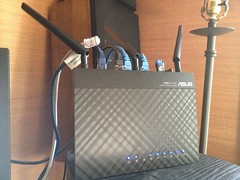 I admit it. I’ve been having some network trouble at home. There are certain requirements I have for The Perfect Router, and I’ve been rampantly accumulating hardware to try to accomplish these requirements:
I admit it. I’ve been having some network trouble at home. There are certain requirements I have for The Perfect Router, and I’ve been rampantly accumulating hardware to try to accomplish these requirements:
- The router must not need to be periodically rebooted to stay functional
- Wireless coverage must be very wide and fast
- There must be an easily-accessible isolated wireless guest network
- The router must include built-in always-on VPN server functionality
- There needs to be parental controls
- If all else fails, it needs to be compatible with DD-WRT
I have a stack of seven routers here in the office that haven’t made the grade. I’ve got everything from a WatchGuard Edge router, which is an amazing piece of consumer-expensive hardware, to some off-the-shelf garbage from Linksys.
I was using Verizon’s stock Actiontec router for a while because it has the MoCA (coaxial) port on it, but since we canceled the TV service, that’s no longer needed. The router itself was ok, but the interface to access it was infuriating, and the wireless coverage was average. My office is a Faraday cage, from which no radio signals seem to be able to escape, and routers have all kinds of trouble maintaining a good signal to allow the connection of devices to the wireless network.
I tried a Netgear WDNR3700, which was a router I used to use regularly and functioned pretty well until it started having unexplained intermittent issues connecting. Every so often it would simply require a reboot to allow connection to resume. This wouldn’t be so bad except that it would happen when I was trying to work remotely and access my home network, leaving me stranded, which is unacceptable.
I later resurrected the WDNR3700 with DD-WRT firmware. The DD-WRT firmware worked great, but the router still seems a little flaky. Currently, this router is being used with DD-WRT as a network client bridge in my family room, since other attempts at extending the network outside of my office (powerline, dedicated wifi bridge hardware) have proved inadequate. It’s working ok in that position, but I think there’s a configuration kink (this is a recent change to the network) that prevents the bridge from accessing other systems on the LAN. This is inconvenient and needs to be corrected.
I tried a Netgear Prosafe SRXN3205, which is a small business class router with VPN server built in. There is a neat feature in this router that, when you connect to it with a web browser, allows you to install a Java-based VPN client on the computer you’re accessing it with. The feature is neat, but I could not get it to work. The configuration of this router is described as “for networking professionals”, which I admit I am not, but having seen it, I pity the professionals that have to look at this UI. I assume that I would have figured this out eventually, but the nail in the coffin was the lack of wireless guest network support. Not sure why Netgear would omit that simple feature, but it’s a deal-breaker.
I got a Linksys EA4500 thinking it was the more DD-WRT capable Linksys E4200. The EA4500 won’t take DD-WRT, rendering it quite useless to me. It didn’t even make it out of the box.
So what router did I finally settle on?
Currently installed is the Asus RT-N66U Dark Knight. This router does everything I want. The wireless coverage is amazing; I can now hit my own router from across the street at the school bus stop, which will be very useful, and was completely unexpected based on prior router performance. There’s a built in PPTP VPN, which isn’t the most secure (says the internet) but is actually useful.
The RT-N66U’s parental controls are a little low-rent. There is an access scheduler, but there is no content or IP filter. I’m not sure if I’ll need such a thing, but having it there makes me feel better about what the kids are seeing on the web.
Guest network access is great on the Dark Knight. You can configure multiple guest networks across either of the two radio bands, and choose whether to allow or deny access to the local network. The guest network access can also be duration-limited, which is a feature I had not seen in a router before.
I have had no trouble with the router staying online. The built-in gigabit switch is super-fast and works well with the NAS, sometimes being able to transfer large files faster than moving them between local drives. The router has the usual NAT and port opening controls, with PnP configuration. There are two USB ports which can be used for NAS storage or even printers. I currently have only a small flash drive plugged in, but may install a couple of drives in the future.
And if all else fails, this router is DD-WRT capable, so I can flash the firmware and get all of the above features plus the additional functionality provided by the DD-WRT package (better parental controls/filtering, DNS server, OpenVPN).
It’s been a while since I’ve been pleased with a network-related device. The Asus RT-N66U is the nicest router I’ve used in a while. If it continues to run as flawlessly as it has for the past week, it will be the best network device on my network, which is something significant, indeed, and also as it should be.